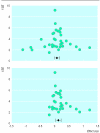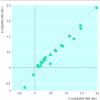Empirical assessment of effect of publication bias on meta-analyses
- PMID: 10845965
- PMCID: PMC27401
- DOI: 10.1136/bmj.320.7249.1574
Empirical assessment of effect of publication bias on meta-analyses
Abstract
Objective: To assess the effect of publication bias on the results and conclusions of systematic reviews and meta-analyses.
Design: Analysis of published meta-analyses by trim and fill method.
Studies: 48 reviews in Cochrane Database of Systematic Reviews that considered a binary endpoint and contained 10 or more individual studies.
Main outcome measures: Number of reviews with missing studies and effect on conclusions of meta-analyses.
Results: The trim and fill fixed effects analysis method estimated that 26 (54%) of reviews had missing studies and in 10 the number missing was significant. The corresponding figures with a random effects model were 23 (48%) and eight. In four cases, statistical inferences regarding the effect of the intervention were changed after the overall estimate for publication bias was adjusted for.
Conclusions: Publication or related biases were common within the sample of meta-analyses assessed. In most cases these biases did not affect the conclusions. Nevertheless, researchers should check routinely whether conclusions of systematic reviews are robust to possible non-random selection mechanisms.
Figures


Comment in
-
Passive smoking: wider evidence needs to be interpreted.BMJ. 2003 Aug 30;327(7413):501; author reply 504-5. doi: 10.1136/bmj.327.7413.501-a. BMJ. 2003. PMID: 12946975 Free PMC article. No abstract available.
-
Review of publication bias in studies on publication bias: here's a proposal for editors that may help reduce publication bias.BMJ. 2005 Sep 17;331(7517):638. doi: 10.1136/bmj.331.7517.638-a. BMJ. 2005. PMID: 16166149 Free PMC article. No abstract available.
-
Review of publication bias in studies on publication bias: meta-research on publication bias does not help transfer research results to patient care.BMJ. 2005 Sep 17;331(7517):638. doi: 10.1136/bmj.331.7517.638. BMJ. 2005. PMID: 16166150 Free PMC article. No abstract available.
References
-
- Song F, Easterwood A, Gilbody S, Duley L, Sutton, AJ. Publication bias. In: Stevens A, Abrams K, Brazier J, Fitzpatrick R, Lilford R, eds. Handbook of research methods for evidence-based health care—insights from the NHS HTA programme. London: Sage Publications (in press).
-
- Horton R. Medical editors trial amnesty. Lancet. 1997;350:756. - PubMed
-
- Easterbrook PJ. Directory of registries of clinical trials. Stat Med. 1992;11:345–423. - PubMed
-
- Begg CB. Publication bias. In: Cooper H, Hedges LV, editors. The handbook of research synthesis. New York: Russell Sage Foundation; 1994. pp. 399–409.
-
- Begg CB, Mazumdar M. Operating characteristics of a rank correlation test for publication bias. Biometrics. 1994;50:1088–1101. - PubMed
MeSH terms
LinkOut - more resources
Full Text Sources
